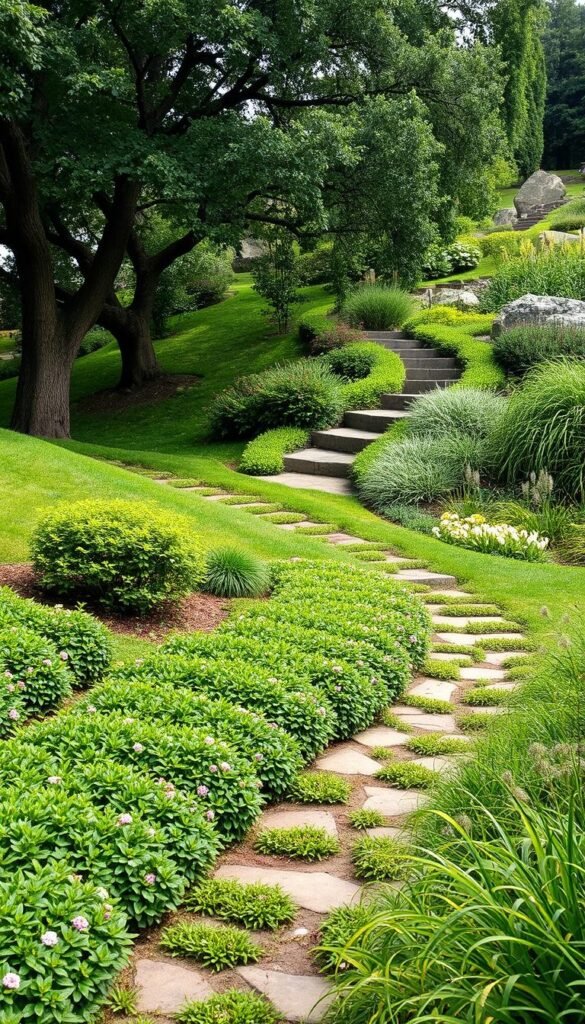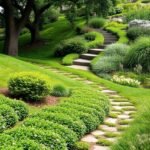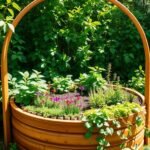Have you ever stared at a sloped yard or mature trees and wondered how to make them part of your dream outdoor space? You’re not alone. Many homeowners see uneven terrain as a problem, but natural slopes and established trees can become your greatest allies in creating a unique landscape.
The secret lies in working with your property’s features rather than against them. A winding path through changing elevations feels more inviting than a straight downhill march. Strategic planting turns tree roots into natural staircases, while slopes create perfect spots for hidden seating areas.
Think of your yard’s existing layout as a treasure map. Those mature trees provide instant shade and privacy screens. A steep incline becomes an opportunity for cascading flower beds or a terraced vegetable patch. You’ll save money on earthmoving and gain a landscape that feels effortlessly connected to its surroundings.
This approach isn’t just practical—it’s sustainable. By using what’s already there, you reduce water runoff and soil erosion. Your garden becomes a living ecosystem where every slope and tree trunk plays a vital role. Ready to turn those “challenges” into showstopping features? Let’s explore how.
Assessing Your Garden’s Terrain and Natural Elements

What if your yard’s natural curves hold the blueprint for a stunning landscape? Start by understanding three core elements: soil composition, water flow, and elevation changes. These factors determine which plants thrive and where to place features like paths or seating.
Soil, Drainage, and Slope Evaluation
Grab a simple level and notebook. Measure slope steepness in different areas—gentle (under 10°), moderate (10-25°), or steep (over 25°). This affects erosion control methods. For example, steep slopes often need terraced beds or retaining walls.
Test your soil using a DIY kit from any garden center. Sandy types drain fast but struggle to hold nutrients. Clay retains water but becomes slippery on slopes. Loam? That’s gold—it balances drainage and moisture retention perfectly.
| Soil Type | Drainage Speed | Erosion Risk | Ideal Plants |
|---|---|---|---|
| Sandy | Fast | High | Lavender, Sedum |
| Clay | Slow | Medium | Daylilies, Birch |
| Loam | Moderate | Low | Most vegetables |
Identifying Existing Trees and Landscape Markers
Map tree canopies and root zones with spray paint or flags. Healthy oaks or maples create natural shade patterns—perfect for ferns or hostas. Unstable trees? Their removal might elevate your space for new designs.
Track how rainwater moves during storms. Look for pooling spots near tree bases or fast-flowing channels on slopes. These clues help position rain gardens or dry creek beds that manage water naturally.
Recognizing the Unique Challenges of Sloping Gardens
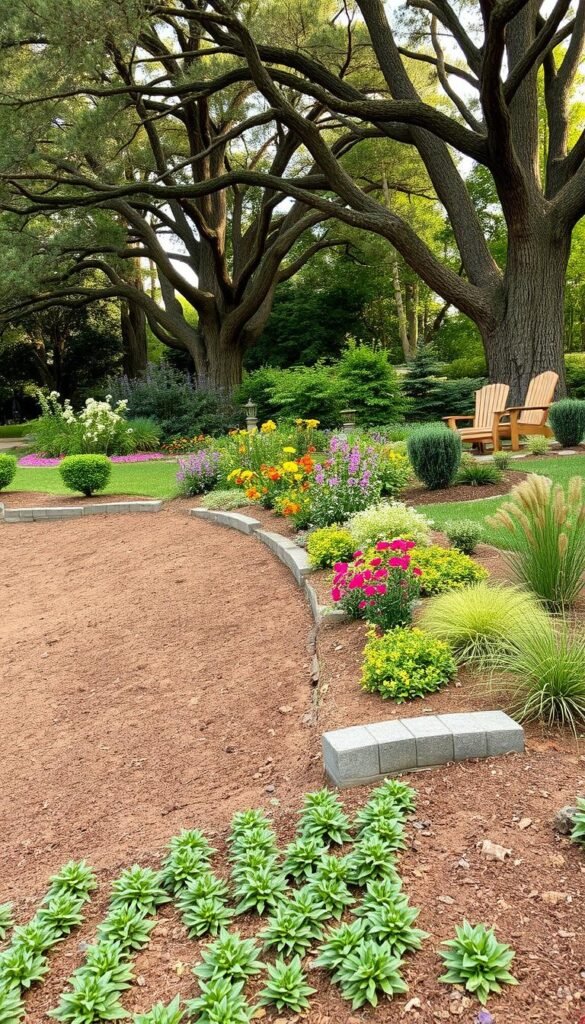
Erosion on slopes isn’t just messy—it’s a threat to your landscape’s foundation. Rainwater gains speed as it flows downhill, acting like nature’s power washer that strips away precious topsoil. Left unchecked, this can expose plant roots, create unsafe walking surfaces, and wash away your hard work.
Managing Erosion and Soil Instability
Watch for telltale signs like winding channels in the soil or plants leaning downhill. These red flags mean water is winning the battle against your slope. Sandy soils disappear fastest, while clay becomes slick and unstable when wet.
Solutions start with working smarter, not harder. Native grasses with deep roots act like living nets, while strategically placed rocks break water’s momentum. For steeper areas, terraced beds create flat planting zones that let water soak in gradually.
Timing matters most after disturbing soil. Sow quick-growing ground covers within two weeks to protect bare earth. In colder regions, tackle major projects before summer droughts or winter freezes arrive. Remember: every slope has its personality—what works for a gentle 10° incline might fail on a 30° hillside.
Adapting Your Garden Design to Work with Existing Trees and Slopes
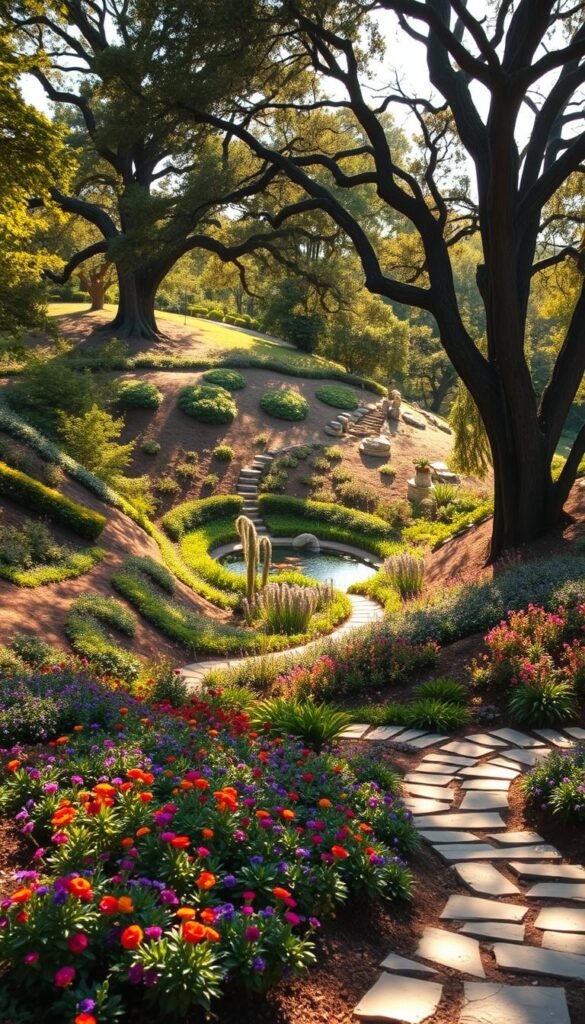
What if your garden’s hills could guide visitors on a scenic journey? Sloped spaces become magical when you let the land dictate movement. Winding paths that follow natural contours feel more inviting than rigid walkways, creating discovery around every bend.
Embracing the Sloping Aesthetic for Balance and Flow
Selective editing often yields better results than adding features. Remove elements competing with your landscape’s natural rhythm—like straight stairs cutting across slopes. Instead, let mature trees frame curved stepping stones that mirror the hill’s curves.
Curved lines in hardscaping soften steep grades visually. A meandering stone path beside an oak’s trunk draws the eye horizontally across slopes. This creates balance between vertical drops and flat areas.
Purposeful landscaping uses existing trees as living waypoints. Their canopies become natural ceilings for seating nooks carved into hillsides. You’ll create interest through elevation changes while maintaining easy navigation.
This approach reduces maintenance through smart integration. Native plants stabilize soil on inclines naturally. Strategic gaps between plantings let rainfall absorb rather than erode earth. Your space matures gracefully while staying true to its original character.
Designing Seamless Transition Zones with Curved Pathways and Retaining Walls

Imagine moving through your landscape as smoothly as water flows downstream. Curved pathways act like nature’s guide ropes, helping visitors navigate elevation changes without jarring transitions. When paired with retaining walls, these features create organic connections between garden levels while preventing soil erosion.
Curved Steps for Gentle Slopes
Winding steps work best when they mimic natural land contours. Start with large anchor stones at turns—these act like punctuation marks in your garden’s “sentence.” Fill between them with smaller flagstones or gravel for texture variation. As the Fairlight End study notes: “Creating a winding route edged with plants frames each step like living handrails.”
Selecting Materials That Complement Your Landscape
Choose stone colors matching existing outcroppings or your home’s foundation. Timber accents add warmth near wooded areas. For walls, stack blocks with a slight backward tilt (1″ per foot) and backfill with gravel—this combo improves drainage while locking structures in place.
Remember: simple materials age gracefully. A mix of irregular stones and weathered wood looks intentional rather than manufactured. These elements become part of your landscape’s story instead of fighting against it.
Integrating Multi-Tier Planting for Depth and Visual Interest

Layered planting turns slopes into living art galleries. A three-tier system uses ground covers, shrubs, and trees to create depth while solving practical challenges. This approach maximizes vertical space and reduces erosion—perfect for sloped areas where flat surfaces are limited.
Layering Ground Covers, Shrubs, and Trees
Start with creeping thyme or sedum at ground level. These plants form living carpets that stabilize soil. For middle layers, feather reed grass adds movement, while hydrangeas offer seasonal color bursts. Taller background shrubs like viburnum create natural privacy screens.
| Tier | Plant Examples | Key Benefits |
|---|---|---|
| Ground | Sedum, Sweet Woodruff | Erosion control, weed suppression |
| Middle | Butterfly Bush, Black-Eyed Susans | Color variety, pollinator support |
| Background | River Birch, Leyland Cypress | Wind protection, year-round structure |
Creating Focal Points and Private Garden Spaces
Use specimen plants like Japanese maple to draw the eye. Cluster odd numbers of shrubs (3 or 5) near seating areas for intimate nooks. For small-space solutions, mix dwarf mondo grass with vertical vines on existing trees.
Rotate seasonal bloomers between beds to maintain year-round interest. Spring bulbs can transition to summer coneflowers, then fall asters. This layered approach makes every slope level contribute to your garden’s story.
Implementing Water Management with Drip Irrigation and Sustainable Practices
Keeping your landscape hydrated doesn’t have to feel like an uphill battle—especially on slopes. Drip irrigation systems deliver water directly to plant roots through tiny emitters, cutting waste by up to 40% compared to sprinklers. This method lets moisture seep deep into soil, preventing runoff that worsens erosion on inclines.
Optimizing Drainage and Preventing Soil Erosion
Position drought-tolerant plants like lavender at slope tops—they’ll thrive with minimal water. Thirstier varieties, such as ferns, belong at the bottom where moisture pools naturally. Mulching each tier locks in hydration and shields bare earth from heavy rains.
Summer maintenance focuses on monitoring upper slopes, which dry fastest. Pair timed drip irrigation cycles with permaculture principles like swales—shallow ditches that redirect water across hillsides. These strategies turn tricky terrain into a self-sustaining ecosystem that outlasts dry spells.

